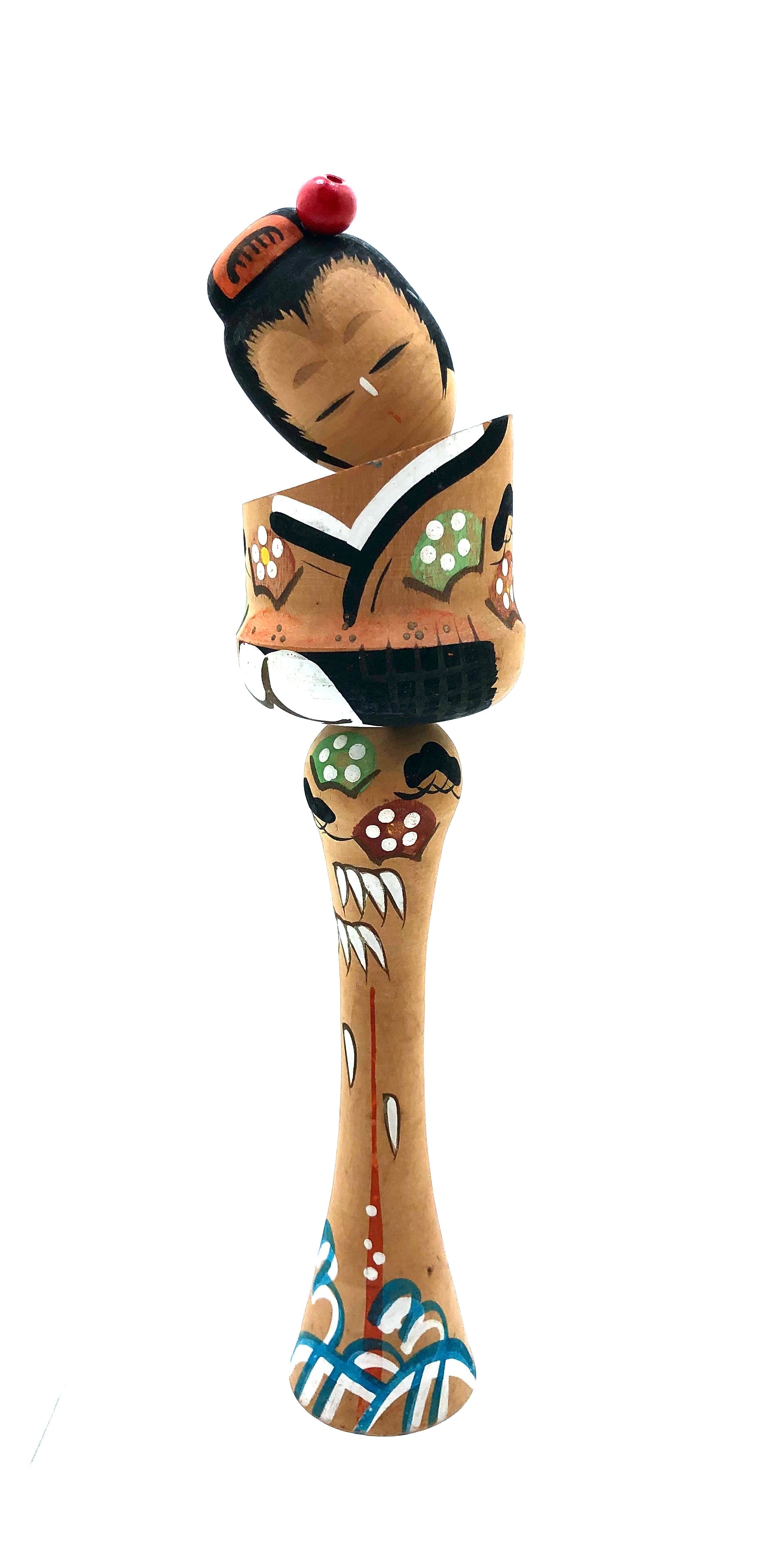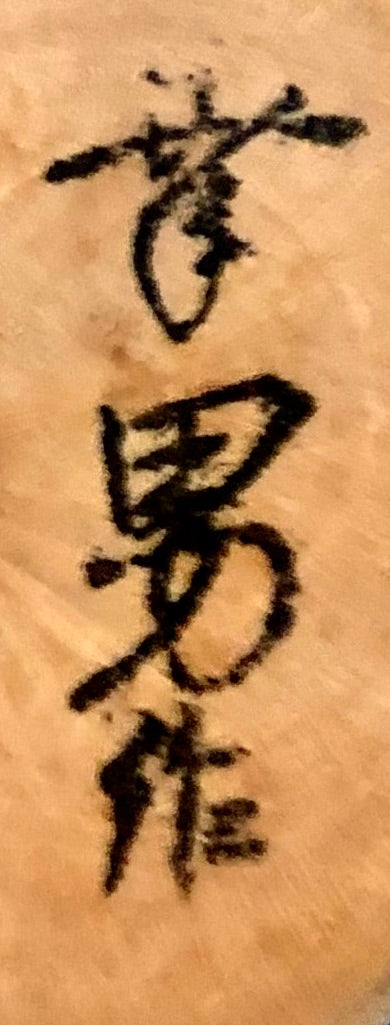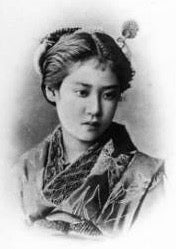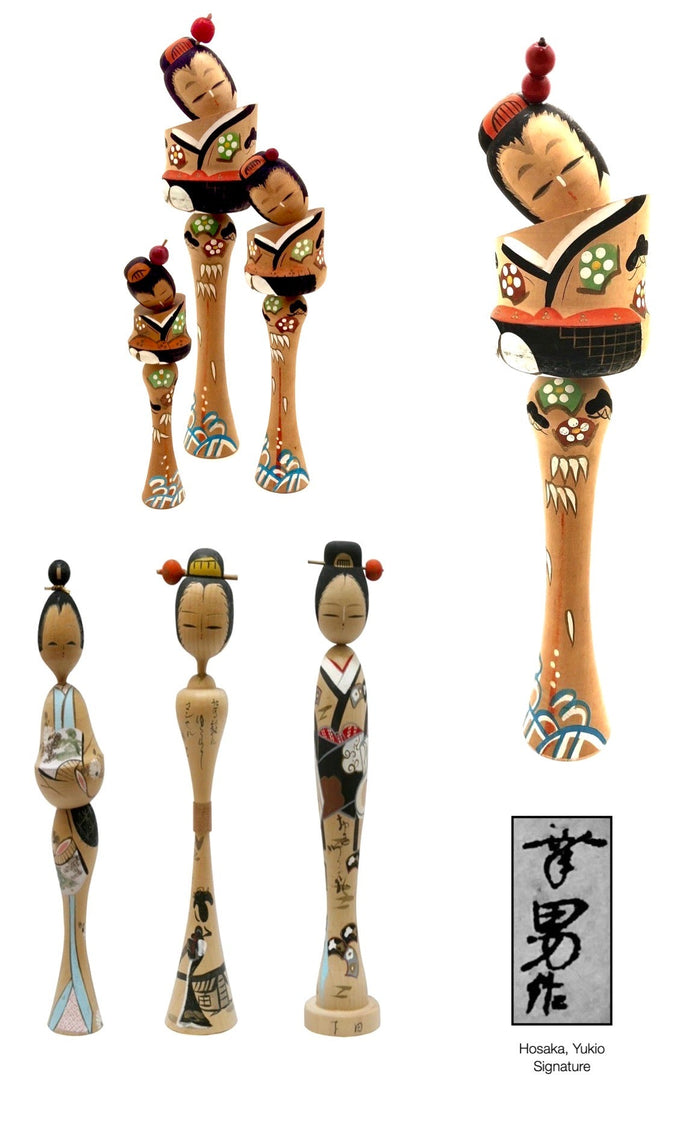


Antique Sosaku Kokeshi of Saito Okichi by Hosaka, Yukio
Dimensions: 9-0"h
Japanese Kokeshi are known to celebrate and immortalize Japanese traditions, values, and nature that remain important factors in everyday life and tradition. This doll is a perfect example of documenting history and important individuals throughout the country.
This very RARE doll that represents a traditionally-costumed Japanese woman with her head slightly tilted as if she is performing in a traditional dance. She exhibits elegantly coiffed hair with the traditional hair accessories (Kanzashi Hairpin with red lacquered Tama Beads), and painted blue, orange, white and black Kimono and Obi illustrating waves, fans, bamboo and flowers. She is very contemporary and modern-styled as seen in the beautiful painting and details of her clothing. Signed by the artist Hosako, Yukio, who is the only artist that has depicted this historical figure. Because of the rarity of the piece it is signed by the artist Hosako, Yukio, that been featured in two books on the subject of Japanese Sosaku Kokeshi, and one book written on her life. Because this doll is rarely seen outside of Japan, the piece took years to locate.
Condition: Excellent remarkable, original condition with no cracking, fading, missing parts, discoloration or repairs, with gentle wear from handling. Beautifully preserved, “as is”, and commensurate with age.
NOTE: The Legend
One of the most popular historical Kokeshi figures is that of a woman named Saito Okichi. Even though the real truth of her existence is still in question, the true bittersweet love story between Okichi and her intended husband, Tsurumatsu is one legend readers never forget.
According to legend, she was born in 1841, in a small fishing village of Shimoda, on the Izu peninsula. Shimoda was the location of Commodore Matthew Perry’s first landing, in 1853. Perry had sailed there with the intention of opening a trade agreement between Japan and the west, and the Treaty of Kanagawa resulted from this first visit, ending Japan’s centuries old self-imposed isolation. He returned again in 1856 as the first Consul General to Japan, and remained there for the better part of six years.
As the story goes, one of Perry’s aids, a Townsend Harris, became infatuated with Ms. Saito who was engaged to a carpenter by the name of Tsurumatsu. When the government officials got wind of this, they forced the young woman, was 15 at the time, to become Harris’ mistress, in the hopes that this would greatly improve trade negotiations with the United States.
Japanese officials wanted Ichibei out of the picture and offered him the rank of Samurai as a bribe if he acquiesced to the barbarian Harris’s desire for his sweetheart. Okichi-san, after pressure from the government, reluctantly agreed to become the concubine to the middle-aged consul, Mr. Harris.
Five years later, however, Harris returned to the United States, leaving a bereft and embarrassed Okichi-san behind who had a reunion with Tsurumatsu, and soon became a target of enmity by the villagers of Shimoda, and who began to call her a “tojin”, (a foreigner’s concubine). Having been thusly stigmatized for having a relationship with the foreigner, Okichi-san was driven to drink and despair, and eventually committed suicide by drowning at age of 51. She eventually was immortalized in a small museum inn Shimoda. And finally, a wonderful paperback book was written on her life entitled: Butterfly in the Wind by Rea Kimura.

Artisan
Woodworker: Hosaka, Yukio
1933-
Biographical History:
As collectors, we felt it was most important to represent all Sosaku Kokeshi artists, whether or not each artist has a written account of his/her life. We show the diversity of cultural values and the creative work produced by a multitude of artists. In researching old writings through articles and books that remain, it is evident that the Kokeshi Craftsperson not only created beautiful forms as toys, but also kept alive cultural values, customs, and fashion through the extensive representations of Kokeshi dolls. The beauty is in the doll and not the signatures, for most masters never signed their dolls. Later they named the dolls, but only when Westerners insisted on signatures because they did not know the artists, so the carvers began to sign their works, for the carvers wanted to promote sales to make a living, during the seasons that did not provide an environment to continue their otherwise daily work.
Other than the name of the Kokeshi artist and the book that was written entitled: Butterfly in the Wind by Rei Kimura, nothing is recorded about Hosaka-san and the date of her birth. The writer, who documented the life of Ms. Saito, who was born in 1841, and became a concubine of an Aid of Commodore Perry and a member of the first American Consul in Japan, there is little biographical information on this artist who created these beautiful figures.
Collector's note – descriptive qualities, standard characteristics & ornamentation styles:
These creative Kokeshi are always pictured as tall slender figures with tilted heads and Kansashi interwoven into their hair. All have beautifully colored kimonos exhibiting traditional motifs of flowers, bamboo leaves, pine trees, a fan, and the sea. All of Hosanna’s dolls were wrapped tightly in the upper portion of the kimono with a very tight lower half of the garment.
Explore & Learn More about Woodworker: Hosaka, Yukio